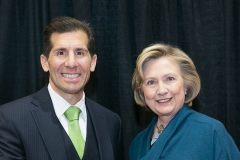PBS’ Shortwave with P.J. Tobia spoke with ERI CEO John Shegerian to investigate further how exporting electronic devices is endangering national security, especially as our nation’s top defense institutions are unknowingly buying counterfeit devices, i.e. its own garbage. In fact, in 2011, a Congressional investigation found 1 million pieces of counterfeit hardware in different military devices.
To listen, follow this link or play below or read the transcription below: http://www.pbs.org/newshour/updates/pentagon-getting-duped-buying-back-ewaste/.
Welcome to Shortwave, a PBS NewsHour podcast on foreign events that have an impact close to home. I’m NewsHour Foreign Affairs and Defense Reporter/Producer P.J. Tobia.
Electronic garbage and discarded appliances are by far the fastest growing type of trash we create. Old computers, cell phones, washing machines, that drone you crashed the first time you took it for a spin, all eventually end up getting thrown away.
Last year we trashed more than 41 megatons of this stuff. For some perspective, if you put all this junk into 18-wheel trucks, the line would stretch from New York to Tokyo and back. By 2018, the world will toss 50 megatons of electronic and electrical goods that have come to called e-waste.
The U.S. Federal Government is a major contributor to this torrent of trash because they buy so many of these products. “The U.S. Federal Government is the largest purchaser of electronics in the United States. Depending on whose numbers you listen to, they purchased approximately 16 to 18 billion dollars worth of new electronics every year.” That’s John Shegerian the CEO of Electronic Recyclers International. Last month alone his company recycled around 25 million pounds worth of castoffs from the digital revolution.
As you can tell, I spoke to Shegerian via cell phone. He was on the road. Apologies for the bad connection.
Like you and me, when the Federal Government is done with its old electronics, the stuff gets thrown away. Some of it gets put in landfills or recycled but not nearly all of it. “A lot of these materials are still being put into containers by people who are quote, unquote or wink wink ‘recycling the stuff,’ but they’re putting it into containers and they’re just selling the containers as is to different parts of Asia, the Middle East, Africa and India.”
This isn’t terribly surprising. Anyone whose been to the developing world and seen kids running around in old Backstreet Boys tee shirt knows that our old trash becomes their new treasure, well, newish anyway. What is surprising is that some of the U.S. Government’s old electronics end up returning to U.S. soil, sold back to the Government as new products and I don’t mean iPhones. “There has been a huge proliferation of counterfeit parts making its way back into our defense systems.”
A 2011 Congressional study uncovered a “flood of counterfeit goods in the defense supply chain.” A total of one million individual parts were found to be old electronics sold to the Government as new. The Pentagon, it turns out, is buying its garbage back and paying top dollar for it. “We ship all our electronics off our shores. Different parts and elements of parts are then mined in Asia and then used to make counterfeit parts, which are then sold back to our defense industry systems who are now trying to make new missile defense systems or whatever, but they don’t know that they’re making it with instead of OEM-generated parts they’re making it with counterfeit parts.” By OEM he means original equipment manufactures. In other words, the contractors the Pentagon buys weapons from.
Like the rest of the world, many of those contractors buy their electronic components from factories in China. Some of those factories in turn are buying the electronic junk that our Federal Government has thrown away.
What weapons systems are we talking about? Well, missiles for one. Here’s former Michigan Senator Carl Levin in a Senate Armed Services hearing on this very issues back in 2011. “There is a flood of counterfeits and it is putting our military men and women at risk and costing us a fortune. In September of 2010, the Missile Defense Agency learned that mission computers for THAAD missiles contained suspect counterfeit memory devices. According to the Missile Defense Agency, if the devices had failed, the THAAD missile itself would likely have failed. The cost of that fix was nearly 2.7 million dollars. Who paid for it? The American taxpayer.”
That hearing was four hours long. They talked about planes, helicopters, and radar systems, all full of processors and microchips that were sold as new but in fact were used. How does this happen? Tell us Carl Levin. “E-waste is shipped into Chinese cities where it is disassembled by hand. Parts may be sanded down to remove the existing part number and other marks on the part that indicate its quality or performance in a process known as Black Topping. The tops of the parts may be recoded to hide sanding marks. State-of-the-art printing equipment is used to put false markings on the parts showing them to be new or of higher quality, faster speed, or able to withstand more extreme temperatures than those for which they were originally manufactured. When the process is complete the parts are made to look brand new to the naked eye.”
It all starts in a Chinese city called Shenzhen. That’s where tons of our cast-off electronics end up. Congress wanted to send an investigative team to Shenzhen to see how used electronics got sold to the Pentagon as new. Senator Levin says they were denied permission to visit by the Chinese Government but Thomas Sharp figured out a way in.
Sharp is an Executive Vice President at SMT Corporation, an electronics component distributor. Both the Pentagon and aerospace industry are SMT clients. Sharp was in Hong Kong on business and took a detour to nearby Shenzhen. What he found there stunned him. “While there I witnessed e-scrap piled outside of buildings throughout large areas of the town and throughout the outskirts of the town. Used electronic parts being washed in a river and laid on the riverbank to dry. Nylon sacks with harvested components being dumped onto sidewalks and sorted by women and children laid out there for the monsoon rains of July to wash them naturally. Cardboard and plastic bins filled with expensive brand-name components and harvested from scrap circuit boards ready for processing.”
After the parts were cleaned up and new serial numbers were added, at least some of them ended up being sold to the U.S. defense industry as brand new products. The national security implications are of course staggering. Things like missile guidance systems are sensitive, precision instruments. But then again, so is medical equipment and some of our old medical equipment is being put to work overseas. “And there are instances and there’s documentation around this issue where old devices are being used and being considered reliable in emerging economies and people are being hurt in their medical treatment by old devices that were gussied up and sold as new or just partial used.”
Besides national security and medical ethics questions, the environmental and even human rights impact of our e-waste is huge. Some of our electronic garbage contains precious metals, precious metals that get extracted by tiny hands. “Children are co-opted into the process and since they don’t have the right tools to recycle these materials they burn the plastic off of all the electronics to get to the metals. The burning of the plastic causes a noxious fume and a poisonous fume that goes into the air so the air is horribly polluted. Then the children continue to try to mine the precious metals out of these electronics using acid baths. They burn their hands. They get maimed.”
Shegerian argues that the way to solve of this is to keep all of the U.S.’s e-waste in the U.S. Of course, he runs a company that makes a lot of money recycling this stuff in the U.S. But at least some in Congress agree with him. In 2013, the Responsible Recycling Act was introduced in the House. It’s a Bill that would have banned the export of most non-working electronic devices, basically ending the sale of our e-waste scraps to buyers overseas. But it has been languishing in Committee and hasn’t even had a hearing. The Pentagon meanwhile has instituted new rules around the buying of electronic parts in an effort to crack down on counterfeiting. Many say it’s just not enough.
That’s it for Shortwave.



















